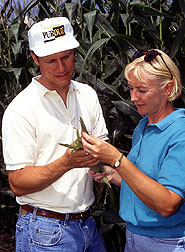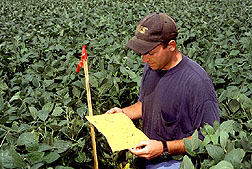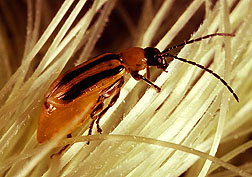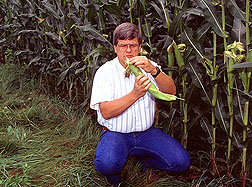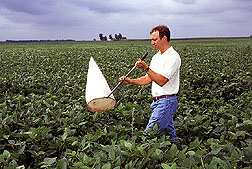Corn Belt Growers Give Areawide IPM A Try
Aerial spraying of bait is a big step toward meeting the USDA goal of using IPM on 75 percent of U.S. cropland by the year 2000.
|
|
Air strikes. SLAM. What's going on in the Corn Belt?
This past summer marked the U.S. Department of Agriculture's first coordinated foray against the corn rootworm, a major insect pest of corn, in their areawide integrated pest management (IPM) war.
Crop dusting planes sprayed a bait made from powdered wild buffalo gourd root laced with a tiny dose of carbaryl insecticide the equivalent of about an ounce per acre. Sold under the trade name Sevin, carbaryl is one of the most common insecticides used by gardeners. The powder-carbaryl mixture also has a binding agent that makes it stick to corn leaves.
The mixture is similar to insecticides that are sprayed as powders or granules, but with one major difference: Instead of killing on contact, the root powder, a delicacy to rootworms, lures rootworm beetles to eat the insecticide.
The lure of the bait seems to reside in the cucurbitacins naturally present in the wild buffalo gourd. Its attraction is so strong that beetles stop dead in their tracks when they sense it and switch from eating plant leaves and other parts to eating mostly bait. They eat so much of the bait that it requires very little insecticide to do the job.
Cucurbitacins are compounds found in the Cucurbitaceae family of plants that includes cucumbers, squash, all gourd plants, watermelons, and cantaloupe. The musky smell released when a cantaloupe is cut open comes primarily from cucurbitacins.
The bait is being tested at four 16-square-mile sites and at one 8-square-mile site. One of them straddles the Indiana-Illinois border, while the others are in Iowa, Kansas, South Dakota, and Texas. Though Texas is not in the Corn Belt, it is seventh in corn production, with crops vulnerable to attack by both western and Mexican corn rootworms.
Actual spraying of the new low-insecticide bait sold by BASF Corporation of Research Triangle Park, North Carolina, under the trade name SLAM will occur for four seasons. The program is being funded for 5 years, including a year's startup in 1996.
First Step Toward a Big Goal
"This test is part of an areawide IPM research program to support the department's goal of having farmers use IPM on 75 percent of the nation's cropland by 2000," says Robert M. Faust of USDA's Agricultural Research Service (ARS). "With IPM, farmers only spray on an as-needed basis using professional scouts to monitor fields and determine if pest numbers are high enough to justify the expense of spraying."
Faust says ARS entomologist Gerald R. Sutter developed the irresistible bait in 1989 at Brookings, South Dakota.
"Larry Chandler, now head of the ARS Crop and Entomology Research Laboratory at Brookings, further developed and tested the bait over the past 3 years," says Faust. "Chandler is co-chair of the special corn rootworm areawide management committee, along with Richard L. Dunkle, who is director of the ARS Midwest Area."
Chandler coordinates a 16-square-mile site in Brookings County. James R. Coppedge, who is in the ARS Areawide Pest Management Research Unit at College Station, Texas, coordinates an 8-square-mile site in Bell County, Texas. The other three sites are coordinated by state agricultural experiment stations.
If the bait is judged a success after 5 years, its use could spread throughout the Corn Belt and reduce total corn insecticide use by half, says Faust, who is the ARS national program leader for field and horticultural crop entomology.
"Mobile pests such as corn rootworm beetles don't respect farm fences let alone county or state borders," he notes. "So IPM is most effective when it's applied over large areas."
That's the concept behind the areawide IPM program: Target a key pest over a large geographic area with all farmers participating, so the pest has nowhere to go to avoid control measures. Other pests in the area are also monitored and dealt with using IPM strategies as needed.
Faust says this is ARS' second areawide IPM project in partnership with state agricultural experiment stations and growers and is the first to focus on corn pests.
"Corn rootworms are the target of almost half the insecticides used in row crops in this country, requiring more insecticide than any other pest. About 25 million acres of corn are treated each year," says Faust. "This bait would save farmers money because corn rootworms can cost farmers up to $1 billion in crop losses and spraying expenses during a bad year.
"Of course, there will also be environmental savings," he says. "For one thing, the cucurbitacins in the buffalo gourd root powder have a bitter taste that repels most other insects, including lady beetles, lacewings, honey bees, and other beneficials."
|
|
But Wayne Buhler, an entomologist with Purdue University in West Lafayette, Indiana, says that the cucurbitacins cause western corn rootworms to feed compulsively on the bait. And they act as a feeding stimulant to other rootworm pests, as well, such as the cucumber beetle.
Buhler coordinates the Indiana-Illinois test site. He says this bait should diminish the need for farmers there to routinely apply a soil insecticide to prevent rootworm larvae damage to corn roots. Soil insecticides are being used increasingly in Illinois and Indiana, in response to the western corn rootworm's recent neutralizing of farmers' crop rotation control strategy.
In the past, to avoid a buildup of rootworms, some farmers planted soybeans instead of corn in alternating years. Rootworms would not lay eggs in soybeans, so corn planted after soybeans would not be at risk of rootworm damage.
Now it appears that the pests have adapted to soybeans in some parts of Illinois and Indiana and begun using it for reproduction, too. By mid- to late-July, a large number of beetles fly from cornfields to lay their eggs in nearby soybean fields. This behavioral change can now result in severe damage to corn planted after soybeans.
Buhler says that annual soil insecticide treatments have long been the practice for farmers who grow continuous corn, planting in the same fields every year, and that more than half of these treatments are probably unnecessary.
|
|
Largely through Buhler's cajoling, 45 of 46 farmers in the Indiana-Illinois project area agreed to participate. The 46th farmer, who farms 50 rented acres on the outskirts of the area, was willing, but the landlord was not.
"We're well above the 90 to 95 percent participation that's necessary for a program like this to be sure pest numbers are kept low," Buhler says.
The Indiana-Illinois target area encompasses about 10,000 acres of farmland. Another 2,000 acres outside the edges of the target section are left unsprayed for comparison.
"The promise," Buhler says, is that "after several years of using areawide IPM, the rootworm beetle population may go so low that it will never pose a serious economic threat as long as the program continues."
It Takes a Team
|
|
The Illinois-Indiana site is typical of the five sites in terms of the broad coalition of people needed to make areawide IPM work: state agricultural experiment station entomologists at Purdue and the University of Illinois, farmers, two pilots who spray pesticides for a living, a fertilizer dealer who sells SLAM, a crop consulting firm for IPM scouting, and the ARS National Center for Agricultural Utilization Research in Peoria, Illinois.
Jon Tollefson, an entomologist at Iowa State University at Ames, is the principal researcher for the Iowa site and agrees, saying that his site has similar research partners. And, he says, ARS is the partner that provides a large amount of financial and technical support.
Tollefson says the key to this program is to see if the private sector can run it. "That's why we're working closely with private industry on this project so we can learn how to transfer the technology to those users," Tollefson says.
Roxanne Shufran, an entomologist at Kansas State University at Manhattan, expects the private sector to take over by the fifth year, assuming the bait IPM program succeeds. "We have hired local college-age youth as scouts, in the hope that they will assist in transferring the technology in Kansas," says Shufran, who coordinates the Kansas site. — By Don Comis.
Laurence D. Chandler is at the USDA-ARS Natural Resources Research Center, 2150 Centre Ave, Building D, Suite 300, Fort Collins, CO, 80526-8119; phone (970) 492-7058
James R. Coppedge is Associate Area Director, Southern Plains Area, 7607 Eastmark Drive, Suite 230, College Station, TX 77840-0000; phone (979) 260-9346







